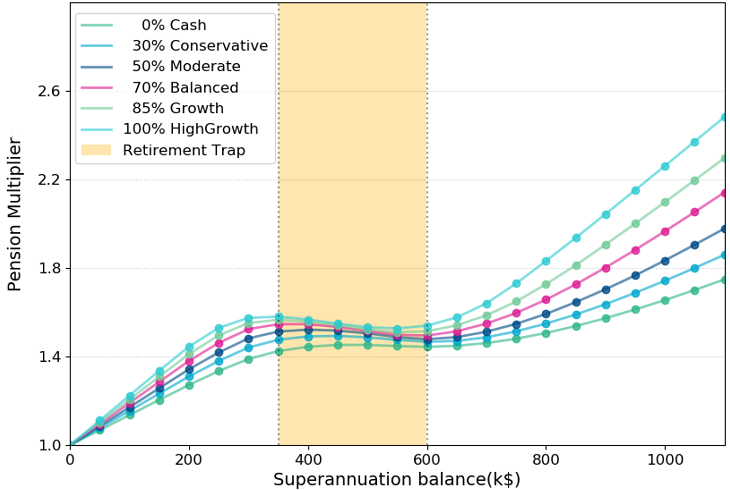Australia’s superannuation system is meant to encourage financial independence in retirement, and to reduce reliance on the Age Pension. For some retirees, though, the retirement system works against these goals and creates a ‘Retirement Trap‘, where saving and investing more can actually result in lower retirement income.
The retirement system in Australia sees retirees drawing income from a combination of superannuation, the Age Pension, and external assets.
The pension is means tested, with entitlements calculated using an income and assets test. As assets and income levels increase, pension entitlements decrease and, at a point, cease. These entitlement levels and associated pension reductions are the primary drivers behind the ‘Retirement Trap’.
What is an ETF: and why should they be part of your retirement plan?
For an individual, there is an income range between $174 and $2026 per fortnight, where for every additional dollar earned, the pension is reduced by 50 cents. This effectively halves the value of additional earnings for retirees in this range.
For individual homeowners whose assessable assets are above $263,250, the pension is reduced by three dollars a fortnight (or $78 per year) for every additional $1000 in assets. To offset this reduction, each $1000, if invested, must generate an annual return above 7.8 per cent.
Work co-authored by Dr Roger Cohen, senior investment specialist for BetaShares, shows that for Australians at retirement age, with savings between ~$350,000 and ~$600,000, increasing their savings may result in their income decreasing. This effect is also called the ‘Pensioner Taper Trap’.
Read: Why ETFs are the ideal retirement investment option
Reductions in income can occur because such savings increases are unlikely to generate enough additional income to offset the pension entitlements that are lost.
To illustrate the Retirement Trap, BetaShares introduced the concept of a pension multiplier. This is a number (greater than or equal to 1), which represents the current or future income stream a retiree can expect relative to the Age Pension (for example, a pension multiplier of 1.5 means that income of one-and-a-half times the government pension can be expected in retirement).
Retirees with a superannuation balance of between ~$350,000 and ~$600,00 will see their pension multiplier decrease as their superannuation balance increases.

The system therefore implicitly encourages these retirees to spend additional savings or redirect them towards exempt assets such as their homes, instead of choosing to invest them to generate income. If a retiree in this scenario does invest their additional savings, they must generate returns of more than 7.8 per cent per annum to exceed the pension entitlements that are lost. This is likely to entail a level of risk that is well beyond what is normally recommended for retirees.
Australian retirees can escape the Retirement Trap only if they can accumulate well over half a million dollars. Above this point increased savings will lead to increased income.
In its submission to the Retirement Income Review Panel, BetaShares outlined the Retirement Trap anomaly, and proposed a new retirement system model that would allow Australian retirees to choose to spend or save additional income or assets based on their personal circumstances, without that choice being distorted by the structure of the system.
The Age Pension would become universal, with the means and assets tests discarded.
ETFs: What are they, why consider them and how to start investing now
Compulsory superannuation contributions would be streamed into defined benefit schemes (to fund the universal pension) and defined contribution schemes (much the same as those that currently exist).
This streaming would be based on age, income, asset balances and other factors. Where a retiree has not fully funded their pension through their defined benefit contributions, the shortfall would be funded by the government. Within defined contribution schemes, individuals would still have flexibility and choice as to where their contributions are directed and how they are invested.
BetaShares acknowledged that such significant changes to the superannuation system would be controversial but argued that the proposed model would not only remove the distortions that discourage a certain group of retirees from increasing their financial independence but would also reduce the financial burden on the government.
BetaShares is a YourLifeChoices partner.
Disclaimer: BetaShares Capital Limited (ABN 78 139 566 868 AFSL 341181) (BetaShares) is the issuer of the BetaShares ETFs. Before making an investment decision, investors should consider the Product Disclosure Statement (PDS), available at www. betashares.com.au. This information does not take into account any person’s objective’s, financial situation or needs and is not a recommendation or offer to make any investment or to adopt any particular investment strategy. Investors should consider the appropriateness of the information taking into account such factors and seek financial advice. Investments are subject to investment risk, investment value may go down as well as up, and investors may not get back the full amount originally invested. ASIC’s MoneySmart website has useful information for people considering investing. The MoneySmart resources can be found at https://www.moneysmart.gov.au/ investing. ASIC’s MoneySmart website has no affiliation with BetaShares.
Do you feel discouraged from achieving financial independence in retirement? Why not share your thoughts in the comments section below?
All content on YourLifeChoices website is of a general nature and has been prepared without considering your objectives, financial situation or needs. It has been prepared with due care but no guarantees are provided for the ongoing accuracy or relevance. Before planning based on this information, you should consider its appropriateness in regard to your own circumstances. You should seek professional advice from a financial planner, lawyer or tax agent in relation to any aspects that affect your financial and legal circumstances.
If you enjoy our content, don’t keep it to yourself. Share our free eNews with your friends and encourage them to sign up.

